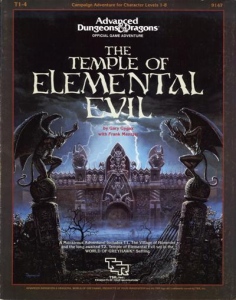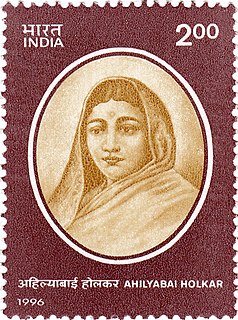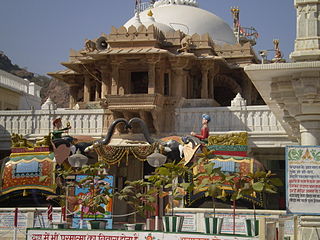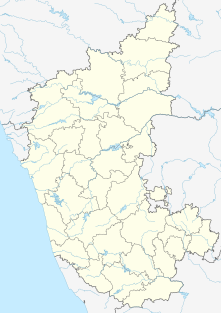
The Temple of Elemental Evil is an adventure module for the fantasy role-playing game Dungeons & Dragons, set in the game's World of Greyhawk campaign setting. The module was published by TSR, Inc. in 1985 for the first edition Advanced Dungeons & Dragons rules. It was written by Gary Gygax and Frank Mentzer, and is an expansion of an earlier Gygax module, The Village of Hommlet. The Temple of Elemental Evil is also the title of a related 2001 Thomas M. Reid novel and an Atari computer game, and the term is used by fans of the setting to refer to the fictional Temple itself.

Māri, also known as Mariamman and Mariaai, spelt also Maariamma, or simply Amman or Aatha ("mother") is the South Indian Hindu goddess of rain. She is the main South Indian mother goddess, predominant in the rural areas of Tamil Nadu and Karnataka. Māri is related with the Hindu goddesses Parvati and Durga as well as with her North Indian counterpart Shitala Devi.

Ahilyabai Holkar was the hereditary noble sardar of the Maratha Empire, India. Ahilya was born in the village of Chondi in Jamkhed, Ahmednagar, Maharashtra. She moved the seat of her kingdom to Maheshwar south of Indore on the Narmada River.

Thirunindravur is a neighbourhood situated on the western part of Chennai, Tamil Nadu, India. It is located around 29 km from Chennai Central railway station. Thirunindravur comes under Chennai Metropolitan Area. The neighbourhood is served by Thirunindravur railway station. It is famous for its temples. The Tiruninravur lake serves the neighbourhood for its water needs.

Nakoda Mewanagar is a village in the Barmer District of Indian state of Rajasthan. The village name is Mewanagar in the Rajasthan state Government records.

Minjur is a town located in the outskirts of North Chennai, India. It is located in the Thiruvallur district in the Indian state of Tamil Nadu. Minjur is called 'Vada Kanchi' meaning North Kanchipuram. The town has two famous temples for Shiva and Vishnu, similar to Kanchipuram. The neighbourhood is served by Minjur railway station of the Chennai Suburban Railway Network.
Padanilam is a small town located in Alappuzha district of Kerala. The word Padanilam means "land of battles" .It is located on the banks of river Achankovil. The Padanilam temple is one of the important centres of worship in Kerala.

Hooli is a town in Belgaum District in Karnataka, India. It is about 9 km from Saundatti. One of the oldest villages in the Belgaum District, Hooli is the site of the Panchaligeswara temple and the Trikuteshwara Temple. The village is historically rich, boasting of a ruined fort atop a hill and numerous temples. Hooli has been under the rule of the Rattas of Saundatti, Patwardhans of Ramdurg and most of the temples feature Chalukya architecture and were initially Jain Bastis indicating a Chalukya rule. The name of the village is a corrupted form of PooValli meaning a flowery ear ornament. The village was also called MahishpatiNagar in ancient times.

Itagi is a village in the southern state of Karnataka, India. It is located in the Khanapur taluk of Belgaum district in Karnataka.

Kunnur is a village in the southern state of Karnataka, India. It is located in the Chikodi taluk of Belgaum district in Karnataka.

Madabhavi is a large village located in Athani taaluk of Belagavi district, Karnataka state of India. The village is famous for production leather chappals which have main market in Kolhapur. The village name came from Madya means central and Bhavi means open well. Open well is near panchayat of village.This village Has two Oldest Ancients Temples one Kalbhairava and another one is Madhukeshwar temple.

Savadi is a village in the southern state of Karnataka, India. It is located in the Athani taluk of Belgaum district. Located on the banks of the Krishna river, also called Uttaravahini - which flows northwards at Savadi, most of the population here is largely dependent on agriculture for its sustenance. Animals domesticated are buffaloes, goats, dogs, horse, bullocks, sheep and fowl. Historically being a belt of Jowar cultivation, with the recent irrigation projects near the village, from the past two decades, the chief crop has been sugarcane. Savadi is closely located to many sugar industries of the Krishna basin, and is part of the major supplier belt of sugarcane in Athani Taluk, and consequently Belgaum district.

Telsang is a village in the southern state of Karnataka, India. It is located in the Athni taluk of Belgaum district in Karnataka.There are two freedom fighters from here, one is Shri Dhanavant Rayappa Halingali and another is Shri Baburao Hujare who was the first MLA in Bombay state before Karnataka Yekikarana.

Niha is a village in the Bekaa Valley about 8 km (5.0 mi) north of Zahlé. It is famous for its Roman archeological ruins, and in particular two lower Roman temples that date back to the 1st century AD.
Hanbarwadi is a village in Belgaum district in the southern state of Karnataka, India.
Khavatkoppa is a village in Belagavi district in Karnataka, India.
Koligudda is a village in Belgaum district in Karnataka, India. It is located 120 KM towards north-east from Belgaum. The population of Koligudda is quite diverse in terms of religion and culture. Kannada is the main language. "Koligudda Mata" is the main attraction of the village. Some other places worth visiting in the village are Kalika Devi temple and Hanuman temple. Agriculture is the main source of income for most people. Sugarcane is the main crop because of the enormous scope of its sugarcane cultivation and production facilities. Koligudd village gets two times GANDHI GRAMA AWARD in the span of five year period of 2015-2019.
Sureban is a village in Belgaum district of Northern Karnataka, India. Usually the place is referred to as Sureban-Manihal(Manihal being the neighbouring village. They are separate villages, but in spirit are the same. Both the villages gather at the local 'Santhe '.

Morazha is a village of Anthoor Municipality in Kannur district in the Indian state of Kerala. Before formation of Anthoor Municipality this village was part of Thaliparamba Municipality. Though part of a Municipal Town, Morazha remains like a village.
In religion and spirituality, a pilgrimage is a very long journey or search of great moral significance. Sometimes, it is a journey to a sacred area or shrine of importance to innate faith. Members of every major religion participate in pilgrimages. A person who makes such a journey is called a pilgrim.










